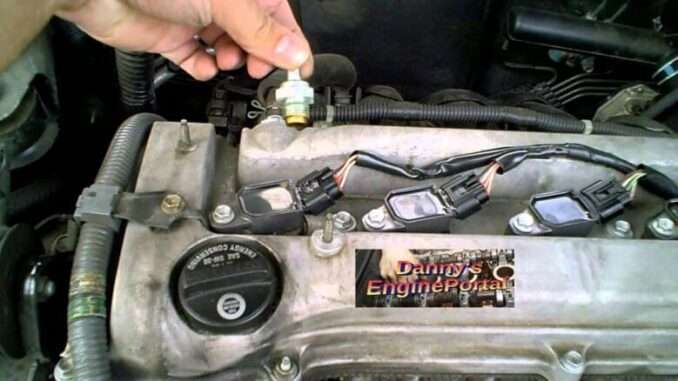
First of all, the (PCV) System is the short form or common name, for the Positive Crankcase Ventilation (PCV) System.
So, the Positive Crankcase Ventilation (PCV) system, is basically a one way passage. And, is used for the blow-by gases to escape, in a controlled manner.
Above all, the (PCV) system, removes harmful vapors from the engine, and prevents them from being expelled into the atmosphere.
First, the Positive Crankcase Ventilation (PCV) system, uses manifold vacuum, to draw vapors from the crankcase, into the intake manifold.
Then, the vapors are carried, with the “air fuel” mixture into the combustion chambers, where they are burned. Consequently, the (PCV) valve controls the flow, and circulation in the system. As a result, the (PCV) valve is effective as both, a crankcase ventilation system, and as a pollution control device. Subsequently, (PCV) systems have been standard equipment, on all new cars since the early sixties.
Even though there are a variety of different (PCV) systems out there, they all function essentially the same.
The Positive Crankcase Ventilation (PCV) System, Can Be Either Open, Or Closed
So, the two systems are quite similar. However, the closed system in use since 1968, is more effective at air pollution control. First, fresh air enters the system. Then, excessive vapor exits the system. The big difference in both systems, is the way they do it.
The Open (PCV) Systems
The open system draws fresh air, though a vented oil filler cap. This presents no problem, as long as the vapor volume, is minimal. But, what if, the vapor becomes excessive. Then, they are forced back, through the vented oil cap, and into the atmosphere. As a result, the open (PCV) system, is not completely effective, as a pollution control device.
The Closed (PCV) Systems
The closed system draws fresh air, from the air filter housing. So, there is no vent in the oil filler cap. The closed system prevents vapor, whether normal or excessive, from reaching the open atmosphere. As a result, the closed system is very effective, as an air pollution control device.
The Positive Crankcase Ventilation (PCV) Valve
Commonly referred to as the (PCV) valve, the flow control valve, is the most important part. The purpose of the (PCV) valve, is to meter the flow of vapor, from the crankcase to the intake manifold. This is necessary, in order to provide proper ventilation for the crankcase. While, not upsetting the “air fuel” mixture for combustion.
How The (PCV) Valve Works
Blow-by gases and vapor should be removed, at about the same rate they enter. Blow-by is minimal at idle and increases, during high speed operation. So, the (PCV) valve, must control the flow of vapor accordingly. The (PCV) valve, compensates for the engine ventilation needs. Consequently, changing at varying engine speeds. Manifold vacuum controls the (PCV) valve. And, the vacuum increases or decreases, as the engine speeds change.
For example, at low or idle engine speeds, manifold vacuum is high. This pulls the plunger to the extreme forward position, or manifold end of the valve. The result is, reduced vapor flow. The low rate of flow, is adequate for ventilation purposes, and will not upset the “air fuel” mixture ratio.
However, higher engine speeds, lower the amount of vacuum. So, the plunger is only moved, midway in the housing. This allows for a maximum flow of vapor. Since the engine needs more “air fuel” mixture at high speeds, the introduction of more vapor, does not affect performance.
Engine Backfire Protection
But, what if you have a backfire? Then, pressure from the intake manifold, forces the plunger to the closed position. Above all, this prevents the backfire flame, from reaching the crankcase, and exploding the combustible vapor.
Failure From Neglect
A neglected Positive Crankcase Ventilation (PCV) system, will soon fail to function. That’s why, the crankcase needs to be, adequately ventilated. If not, the engine oil will quickly, become contaminated. As a result, heavy sludge accumulations will begin to form. Internal parts, not protected by the engine oil, will begin to rust and/or corrode.
This will happen, due to the water and acids, that will become, trapped within the crankcase. So, if the (PCV) system is not working properly. This, in turn, will upset the “air fuel” mixture and cause, rough idling or even stalling of the engine. Furthermore, intake and exhaust valves, in addition to spark plugs, may well be damaged and become useless.
It’s Better To Replace A (PCV) Valve, Than Clean It
So, cleaning a Positive Crankcase Ventilation (PCV) valve, may only be a short term fix. Because, cleaning a (PCV) valve, will result in a clean (PCV) valve, not a new (PCV) valve. As a result, there are contaminants that will remain in the (PCV) valve, that can never be flushed out. Also, the (PCV) valve has internal parts that develop wear and tear, that a simple cleaning will not fix. That’s why, the suggested replacement intervals, are a maximum of 12 months or 10,000 miles (16,000 km).
Conclusion
So, what should you do:
- Replace the valve, if it is sticking or possibly has sludge.
- Clean all the hoses, and fittings.
- Replace, any cracked or broken hoses.
- Insure the system, has an “air tight” seal.
So, proper maintenance of the Positive Crankcase Ventilation (PCV) system, will help reduce overall emissions. Also, this part may be small, and not cost much. But, plays a huge role, in a healthy running engine.
BY DANNY BENDER




